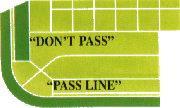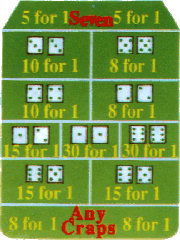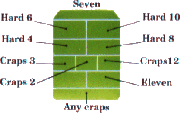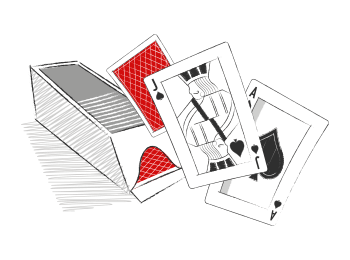Craps is one of the fastest and most exciting games. Although there are numerous rules and multiple variants for this game, the basic rules are rather easy and quick to learn. Four casino employees are present at the craps table (the “boxman”, two croupiers and the “stickman”) who can advise the player.
The game:
The “stickman” puts five dice in front of the player and the player chooses two. The player makes a bet and rolls toward the center of the table. After that, the “stickman” gives the total score and collects the dice with a long stick (“stick”) until all winning bets have been paid out. Then he gives the dice back to the player, who rolls the dice again. The one throwing the dice must also bet on “pass line” or “don’t pass” in addition to all the bets he can choose. All other players can also bet on any combination of the table. The player loses the dice if he makes a seven after the first roll (“called a point”). If the player loses the dice, he loses his turn and the “stickman”

How are the bets made at the craps table?
The “pass line” bet is probably the most well-known and basic of the possible bets in the game of craps. This is made by the player (by you or another player). The rules are not complicated and are easy to remember.

On the first bet ( called a “come out” ), you win if a seven or eleven is rolled and you lose with a two, three, or twelve (craps). Any other result (four, five, six, eight, nine, or ten ) is called “point” and the player rolls the dice again. When you make a “point” the rules change a bit. From that moment on you can only win if the “point” result is reached again and This is independent of the number of throws that are necessary. You only lose with a seven that was thrown before the “point”.

The “don’t pass” bet is almost the exact opposite of the “pass line” bet. In this case, however, the bet is held against the player. You lose if the first roll is a seven or eleven, and you win if it is a two or three. You also lose if you set and throw a “point”. Both sides win if a seven is rolled before the point. The only difference is that if you rolled a 12, you have a stand-off. In this case you lose nor win.
When the point is established, you make a come bet after the first roll and play according to the pass line rules. In this game, you can place a bet on any number of points rolled. Then, as with the “pass line” bet, you win if the next roll is a seven or eleven. You lose if you roll a two, three or twelve. If you roll four, five, six, eight, nine or ten, you get your own come point and the game moves to the “point” field marked on the table. Here, too, you win with a “point”. ‘ before the seven and you lose if you roll a seven before your own ‘point’ has been played again.
The “don’t come” bet is the opposite of the “come” bet and has the same rules. You lose on a seven or eleven and win on a two or three. A twelve is always an invalid roll; you win if you roll a seven before the “point”.
The “field” bet has equal odds and each roll results in a win or loss. “Field” can be played at any point in the game, so there is no waiting for a point. You can get a quick win by betting on two, three, four, nine, ten, eleven or twelve. You only lose with five, six, seven or eight. For a two or twelve, the bet is paid twice.
The “big 6 and 8” bet is an even odds game. It is played by betting on one of these numbers, or both at the same time, at any point in the game. In this case you are simply betting that a six or eight will be rolled before a seven.


Betting on a “seven” and winning pays four times your bet, eleven times it pays ten times, but only for eleven.
- “Craps 2” pays 29 times the bet and you are betting that the score of the next roll will be a two. “Craps 3” pays 14 times the bet and you are betting that the score of the next roll will be a three. “Craps 12” pays 29 times the stake if a 12 is rolled on the next round.
- “Any craps ,” also known as “all craps,” is another single-appearance bet that pays 7 times the bet if a two, three, or twelve wins. You are betting on the bets mentioned above
- “Hardways” consists of betting that pairs will be rolled that add up to an even number. For example: two and two make a four hard, three and three make a six hard, four and four make one Eight “hard” and five and five make a ten “hard”. Any other combination loses (a five and a three make a simple eight, called a “soft”). When betting on doubles, the payout is 7 times the bet for a four “hard” (2 and 2) or for a ten ” hard” (5 and 5) and 9 times the stake for a six “hard” (3 and 3) or an eight “hard” (4 and 4). This bet is not limited to a single roll and stands until you win or loses
„Place Bets”. At any point in the game you can choose whether you want to bet on a single field with the numbers four, five, six, eight, nine or ten. If you bet on a specific number, it must appear before a seven is rolled. That’s the only way to win. The bets on the fields can be made or withdrawn at will. That is, any time before a throw. The winning odds vary: from 9 to 5 for a four or ten, from 7 to 5 for a five or nine, and from 7 to 6 for a six or eight when they win.
Odds can be played with or against the dice but only on the pass-line, don’t pass, come and don’t come bets when the point has been established. It is the player who asks for this variation, and he must wager a sum equal to the original “point” bet when playing the dice. If he plays against the dice, he bets the amount of his own bet. When betting with the dice, one is betting that the player’s points will be gained before a seven comes; when betting against the dice, you win if the seven comes before the other numbers.
The “odds” are paid out as follows: 2 to 1 for four or ten, 3 to 2 for five or nine, and 6 to 5 for six or eight.





